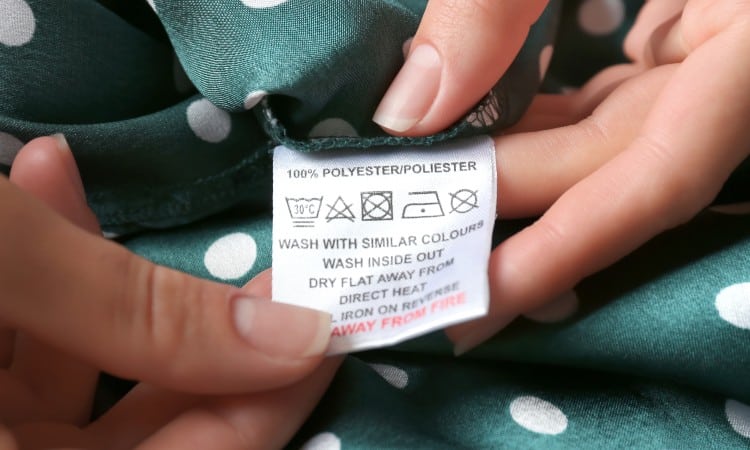Designed for durability, polyester isn’t prone to shrinking. Sometimes though, shrinking a garment is necessary. The question is, how to shrink polyester and what’s the best way?
Shrinking polyester is difficult but not impossible. Synthetic fabrics don’t shrink by design. It is possible to make a polyester garment smaller if needed. Using a washing machine or a dryer on high heat are both ways to shrink polyester. A clothes iron will also work but take care not to melt the fabric.
Each method of shrinking polyester has pros and cons. This article will explore the ways available. Read on to find out how to shrink polyester in the best way.

What Is Polyester?
Polyester is a man-made synthetic fiber derived from petroleum. It was first introduced as a fashion fabric for clothing back in the 1960s and 70s.
Since then it has transformed. Today’s polyester is nothing like the stiff, uncomfortably hot fabric of 1970s leisure suits. Modern production techniques have improved the fabric so much it can be harder to tell some polyester fabrics from their natural cousins.
Take fleece for instance. Unless you know it’s made from polyester, it isn’t immediately obvious. It’s easily mistaken for being wool-based.
Now that polyester is a higher quality, performance material, it has become a popular cheap alternative to cotton. A versatile material, it has become indispensable within the clothing industry because it doesn’t shrink, wrinkle or deteriorate.
Strong, durable, and long-lasting, polyester is moisture and crease-resistant. Ideal for use in outdoor wear, such as the outer shells of rainwear, it can also be used for blouses, shirts, and dresses.
The fabric can be mixed with other materials, such as cotton, to create a fabric with the best of both natural and synthetic fibers. Polycotton is particularly popular for workwear due to its ability to withstand constant washing and yet still be breathable and comfortable to wear.
Synthetic fibers like polyester have a multitude of uses. Polyester can be found in artificial stuffing for soft toys and pillows, plastic water bottles, ropes, hoses, and balloons.
Does 100% Polyester Shrink?

One of the most attractive properties of any synthetic fabric is immunity to shrinking. When it’s made from 100% polyester, you can be sure your favorite shirt will always be the size you purchased. The ability to maintain original proportions is what makes polyester a fantastic clothing fabric.
Being synthetic means the fibers in the fabric are artificial. They don’t expand or contract with different temperatures. Their overall dimensions remain constant.
While the lack of shrinking is normally a good thing, there are times when you might want your 100% polyester pants to be a size smaller. Like if you’ve lost weight or bought the wrong size and can’t take it back. Or maybe you want a tighter, more flattering fit.
Although 100% polyester is designed not to shrink, it can melt. As it’s essentially plastic, extreme heat or any kind of heat can cause it to change both shape and proportions. Which could have the same overall effect as shrinking.
Can You Shrink Polyester?
It’s difficult, but not impossible to shrink 100% polyester. A polyester blend is easier to shrink, although you will still face some challenges. These challenges stem from the amount of polyester in the blend. It will be a lot easier to shrink a fabric with 50% or less polyester in it.
The key to shrinking polyester lies in its most well-known flaw. Polyester is heat-intolerant. Any heat from too hot a wash to a turn in the dryer can cause damage to the fabric. This damage is akin to shrinking. Technically, it’s more like melting but the result is the same.
An absolute minimum heat setting for shrinking 100% polyester is 140oF. For best results, you should aim higher. Somewhere between 155 – 178ºF is thought to be the optimum temperature range for successful shrinkage in 100% Polyester.
Polyester blends can require less heat. The natural fiber content contained in the blend will have shrinking abilities. Which will make it a lot easier to reduce a garment’s size.
Caution should be taken to ensure you achieve an even shrink across the clothing. So make sure the whole garment can be affected by the shrinking method you choose.
How Much Does Polyester Shrink?

The amount a polyester garment can shrink depends on the blend or amount of polyester it contains. If you are working with 100% polyester, the potential shrinkage will be minimal. This is because polyester is essentially plastic and immune to shrinking.
While heat can cause polyester to shrink, it can also damage the fibers in the fabric. Rather than shrinking, the fabric could lose integrity and become a melted sticky mess. Trying to shrink 100% polyester is never easy, nor is it guaranteed to give the effect you were looking for.
A polyester blend, on the other hand, is capable of a larger amount of shrinkage. Take a polycotton blend of 65%-35%. The small amount of cotton will shrink. Under normal circumstances, the shrinkage will be so insignificant you may not notice it.
To purposefully shrink a polycotton garment, you will need to use more heat in the wash than you would normally. Even so, the polyester content will mean the garment shrinks less than it would if it were 100% cotton.
How to Shrink Polyester
When it comes to shrinking polyester, whether it’s 100% or blended fabric, there are a few ways to do it. All of them involve inflicting the polyester fibers to heat. A lot of heat.
Each approach will result in a different level of shrinkage. You may find you have to repeat the steps to get the level of shrinkage you need. There is a word of caution though.
None of the methods should be repeated too often on the same garment. Too much heat will cause irreparable damage to the polyester. It may end up feeling stiff, or worse, melt.
Similarly, using an option best suited to a blend when you’re working with 100% polyester could be problematic. Let’s examine the options and explore which method is more likely to provide the overall effect you are looking for.
Using a Washing Machine

One of the great things about washing machines is the different heat settings. Choosing the hottest setting works well when it comes to shrinking 100% polyester.
All polyesters are heat-intolerant, but when it comes to a pure polyester garment, the hottest setting you can get is best if you want a lot of shrinkage. If all you want is a moderate or slight shrink, choose a lower setting. Medium heat will offer more of a minor shrinkage.
Again, there’s no need for detergent if the clothing is clean. Make sure your garment is inside out before putting it in the machine and simply select the hottest setting.
How much shrinkage you need will determine how you dry the garment. Air drying on a clothesline will give less shrinkage than using a dryer on a hot setting.
| Pros | Cons |
|
|
Using a Dryer
A dryer can be an effective tool in your arsenal for shrinking polyester. The heat and length of time a garment is in the dryer can vary the amount of shrinkage you achieve.
Both 100% polyester and polyester blends can shrink in a dryer. Even if the garment has been washed by hand. Choosing a hotter setting on your dryer than you would normally cause a range of shrink levels from moderate to maximum. Go for a low heat setting if all you need is a minimal reduction in size.
| Pros | Cons |
|
|
Using a Clothes Iron

When it comes to ironing clothes, many of us would prefer to be doing something else. However, iron can be an effective way to get the right amount of shrinkage in your polyester.
This method is a bit more involved than the previous options. It entails washing your garment, either by hand or in a machine, at the hottest level. Remember to turn it inside out to protect the color before putting it in water.
Then, instead of drying the clothing in a dryer or out on a line, you grab your iron and put the still-wet fabric on your ironing board. Make sure you set your iron at low or medium heat.
Using a pressing cloth to protect the fabric, start to gently iron the clothing. You need to do this until the garment is completely dry. Don’t use the steam setting for this method! The steam will create too much heat and cause damage to the garment. Dry iron at a low temperature is the best and safest way to ensure this method shrinks your clothing rather than melting it.
| Pros | Cons |
|
|
Using Boiling Water
This one is fairly straightforward and there are two ways to do it. For both, you will need a pan large enough to keep your garment submerged in the water and a stove.
Wash your garment using the usual washing instructions. Meanwhile, bring a large pot of water to the boil on your stove. While your garment is still wet from the wash, add it to the boiling water.
Continue to boil for around an hour. The actual time will depend on the garment and how thick the fabric is, but an hour is about the same time as a wash cycle, so is a good start. Small garments or thinner fabrics could take less time.
Alternatively, you can bring a large pot of water to the boil and add your garment to it. Boil for about 10 minutes and drain the water. Leave the clothing to cool until it’s hand-hot or room temperature. Then continue to dry using a dryer set on high heat.
| Pros | Cons |
|
|
Using a Clothesline
This method works well on polycotton blends. Due to the cotton content, polycotton is easier to shrink than a pure synthetic fabric.
You will have to wash the garment in a warmer setting than normal. However, polycotton doesn’t need as much heat as 100% polyester to achieve shrinkage.
Before washing, ensure your garment is inside out. This will protect the color and prevent it from fading. Set the washing machine to a hot wash.
The great thing about shrinking polyester is you don’t need to add detergent unless your clothing is dirty. If you’re shrinking new garments or something that has already been washed, hot water on its own will do the trick.
Once washed, hang the clothing on a clothesline to dry. The extra heat from the sun will help with the shrinking process.
| Pros | Cons |
|
|
Tips for Shrinking Polyester
To ensure you get a successful shrink, make sure your clothing is clean before you start. You can wash the garment at the same time as shrinking, but you may find the excess heat traps stains rather than washing them away. This is particularly important if you are using the boiling water method.
Once the clothes are clean, you can add them to the shrink wash without the need for detergent. That way, there are no chemicals clogging up the fibers and preventing them from shrinking.
Polyester can melt under too much heat so be careful with your temperature settings. You may need to adjust them to suit the garment you are working with. Shrinking polyester isn’t an exact science so be sure to monitor the heat level and its effect on your clothes.
Caring for Shrunken Polyester Garments
Once you have shrunk your garment, caring for it post-shrinkage is the same as it was before. The only difference is, now it has been subjected to intense heat, you need to keep it away from any more.
Continued exposure to heat can cause damage to the fibers of the fabric and its ability to remain colorfast. Garments can also become stiff and may lose their durability.
To keep your polyester away from the heat in the future, wash on a permanent press setting or use cold to luke-warm water. For added safety, air dry the fabric so it can dry naturally.
Conclusion
Polyester is a synthetic fiber known for its immunity to shrinking. It is possible to shrink the fabric using high levels of heat. A blend of polyester is easier to shrink. But, using the methods listed above, you can have some success shrinking 100% polyester.
The combination of washing machine and dryer is likely to give good results. Although, the best way to shrink polyester is whichever method works best for you.
Let me know in the comments if you liked the article. Have you tried shrinking polyester? How did you get on and what method did you use?